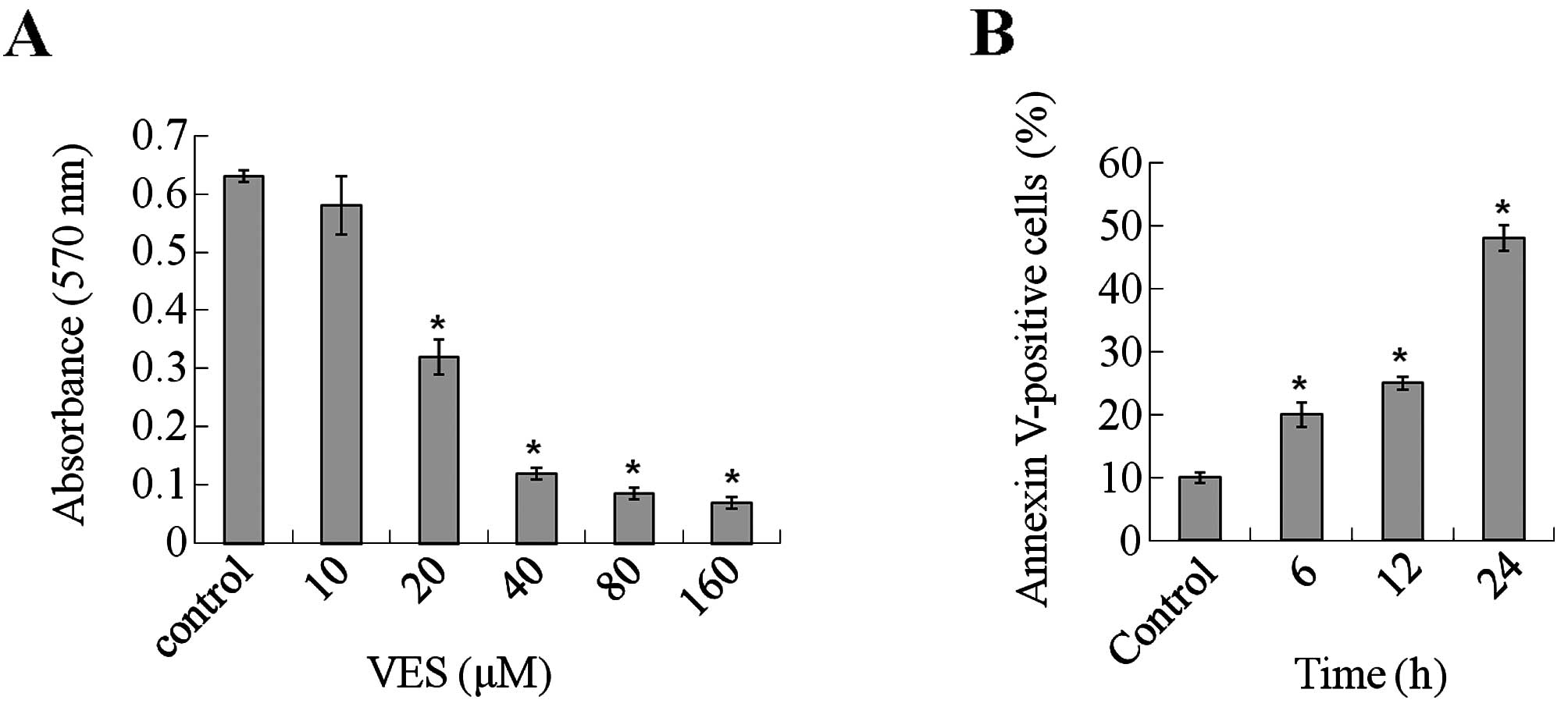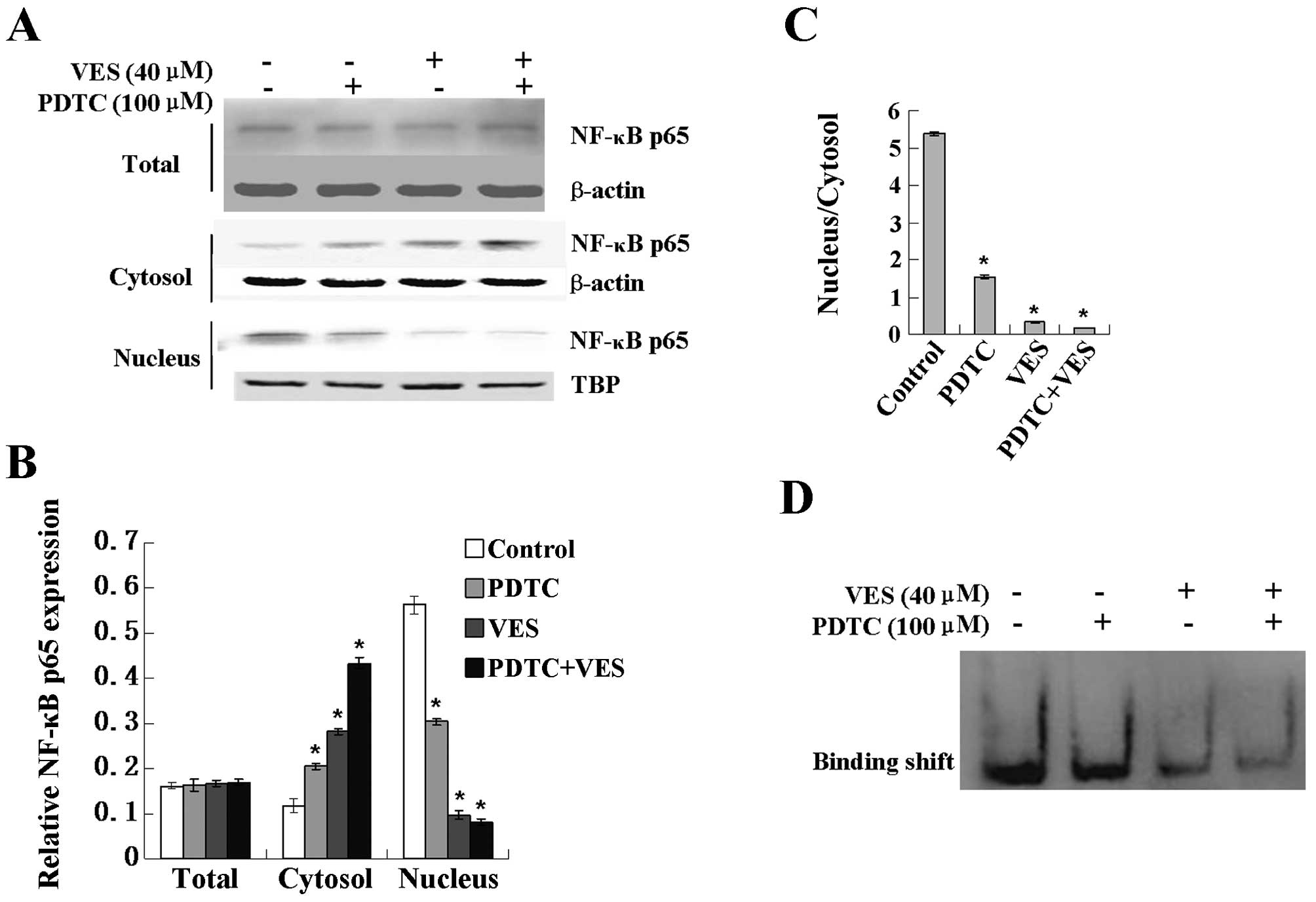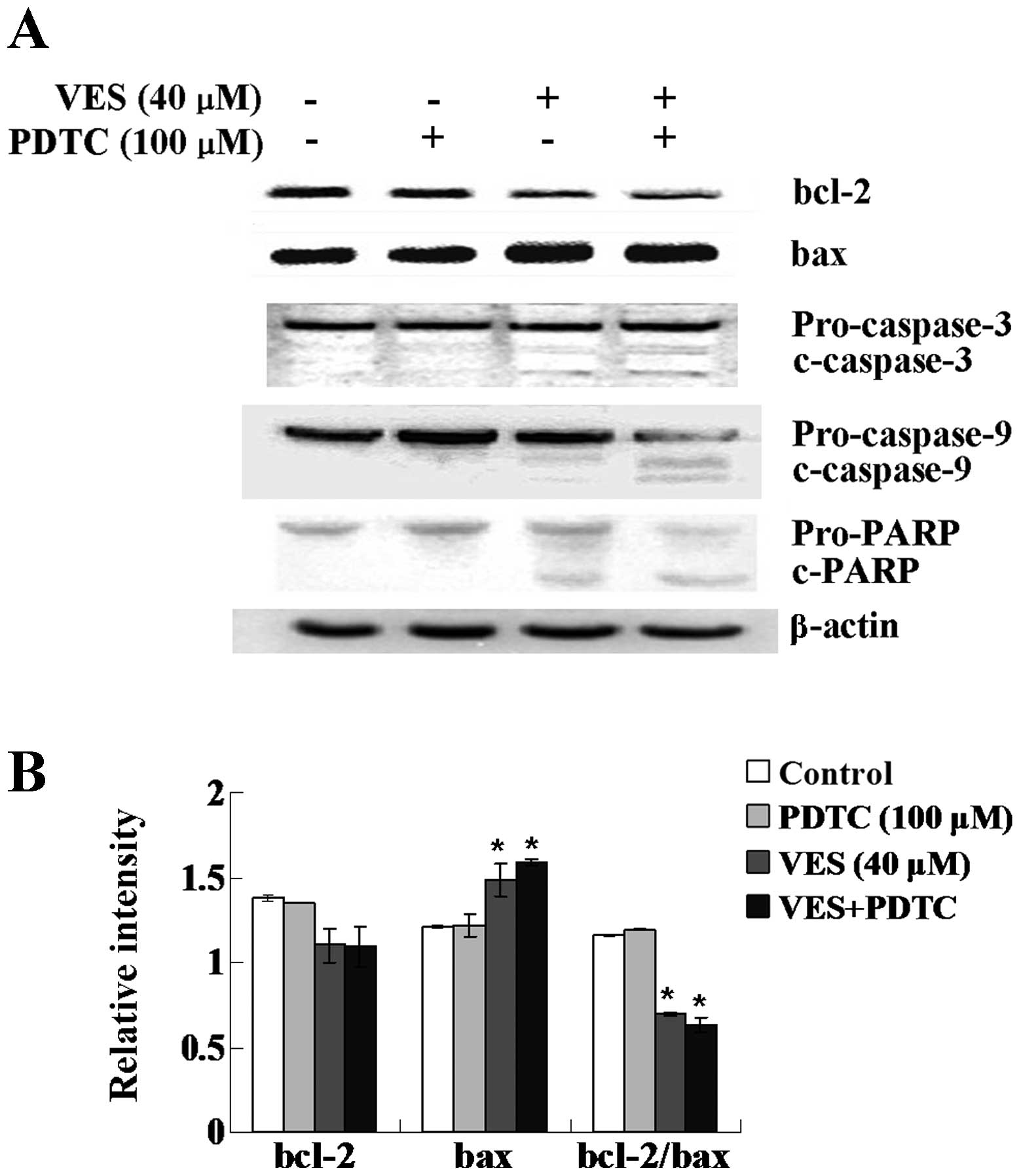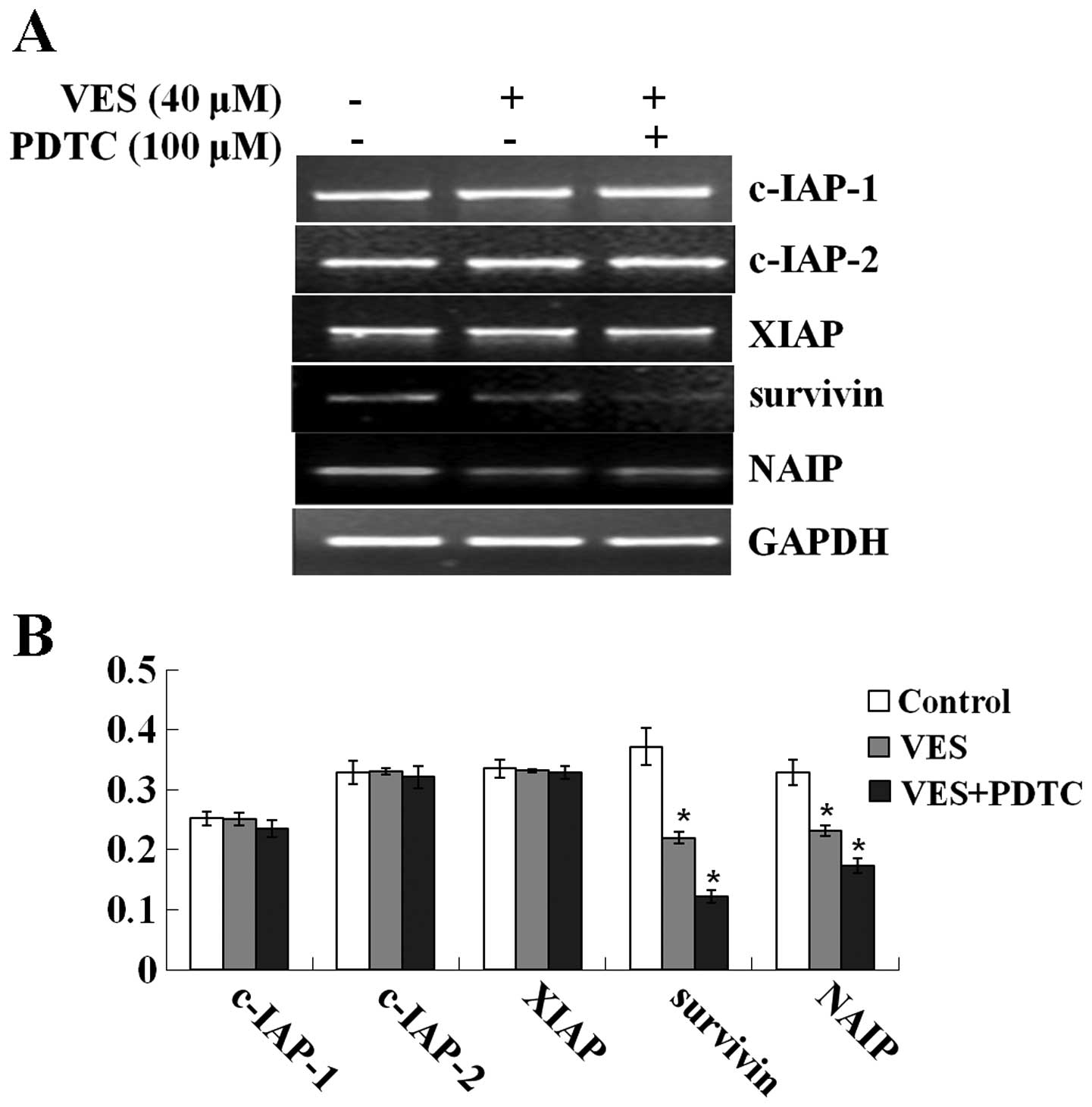RRR-α-tocopheryl succinate induces apoptosis in human gastric cancer cells via the NF-κB signaling pathway
- Authors:
- Published online on: June 23, 2014 https://doi.org/10.3892/or.2014.3282
- Pages: 1243-1248
Abstract
Introduction
Gastric carcinoma is one of the most common causes of cancer-related mortality worldwide; however, there is limited effective clinical treatment for this highly malignant tumor besides surgery and chemotherapy. Furthermore, the treatment outcome remains unsatisfactory as early diagnosis of gastric cancer remains difficult and most patients have already developed metastatic lesions when diagnosed (1). Therefore, it is necessary to search novel agents to treat stomach cancer patients with adverse effects.
An increasing number of publications indicate that vitamin E succinate (VES), a natural derivative of vitamin E, exhibits powerful anticancer effects in a variety of in vivo and in vitro cancer models (2–7). Our previous studies showed that VES induced apoptosis in SGC-7901 human gastric cancer cells via multiple signaling pathways, including extrinsic Fas, MAP kinase, and endoplasmic reticulum (ER) stress (8–10).
The relationship between the dysfunction of the NF-κB signaling pathway and the carcinogenesis of stomach cancer was previously reported by several research groups (11,12). NF-κB is a ubiquitous dimeric transcription factor that plays pivotal roles in regulating the expression of a multitude of critical genes that regulate cell survival, proliferation, apoptosis, immune responses, and adaptive responses to change the intracellular redox balance (13–16). The constitutive activation of NF-κB, a multi-function nuclear factor, has been suggested to be a hallmark of highly malignant tumors (17,18). Therefore, the inhibition of NF-κB activation has been reported to be a naturally useful strategy for increasing tissue sensitivity towards cytostatic drug treatment in vitro and in vivo (19).
Materials and methods
Materials and reagents
Human medium-differentiated gastric cancer SGC-7901 cells were obtained from the Cancer Research Institute of Beijing. VES, ethylenediaminetetraacetic acid, dimethyl sulfoxide (DMSO), MTT, Tween-20, sodium dodecyl sulfate (SDS) and PDTC were purchased from Sigma. RPMI-1640, fetal bovine serum (FBS), TRIzol reagent, an Annexin V-FITC apoptosis assay kit, and a total-RNA isolation kit were obtained from Gibco Chemical Co. (Gibco, Rockville, MD, USA). The GeneAmp RNA PCR kit was provided by Perkin-Elmer Life Sciences (Boston, MA, USA). The enhanced chemiluminescence (ECL) kit and the horseradish peroxidase-conjugated antibody were obtained from Amersham Life Science Inc. Taq polymerase was purchased from Roche Molecular Biochemicals (Basel, Switzerland). The LightShift Chemiluminescence EMSA kit was obtained from Pierce (Rockford, IL, USA). Nuclear and cytoplasmic protein extraction kits and a BCA protein assay kit were obtained from Viagene Biotech (Ningbo, China). Rabbit polyclonal antibodies for Bcl-2, Bax, Bak, caspase-8, caspase-9, caspase-3, PARP, NF-κBp65, TATA binding protein (TBP) and β-actin were purchased from Santa Cruz Biotechnology, Inc. Gene primers of c-IAP1, c-IAP-2, NAIP, survivin, XIAP, and glyceraldehyde-3-phosphate dehydrogenase (GAPDH) for RT-PCR were constructed by Invitrogen.
Cell culture
SGC-7901 were cultured in RPMI-1640 medium supplemented with 5% FBS, 2 mM glutamine, 100 μg/ml streptomycin, 100 IU/ml penicillin, and 20 μM sodium bicarbonate at 37°C in a humidified atmosphere containing 5% CO2. The culture medium was changed every 2 days.
Cell viability
Cells were plated in 96-well plates, allowed to attach overnight, and treated with various concentrations of VES (0–160 μM). Cell viability was estimated using the MTT assay. The medium was aspirated and DMSO was used to dissolve the crystals. Absorbance was measured at 570 nm using a microplate reader.
Assessment of apoptosis
Apoptosis was quantified using the Annexin V-FITC method. Cells were treated with VES (40 μM), and were plated at a seeding density of 105 per well in 24-well plates and incubated overnight. Floating and attached cells were harvested and treated according to the manufacturer’s instructions.
Protein extraction and western blot analysis
After treatment with or without VES or PDTC, the cells were collected and proteins were extracted. The protein concentration was determined by DC Bio-Rad assay according to the manufacturer’s protocol (Bio-Rad Laboratories, Hercules, CA, USA).
For western blot analysis, appropriate amounts of cell lysates (25–50 μg of protein) were separated on 10–15% SDS-PAGE gel and transferred onto nitrocellulose membranes. The membranes were blocked using 5% nonfat dry milk and probed using appropriate primary antibodies in blocking buffer overnight at 4°C. The membranes were then incubated with appropriate secondary horseradish peroxidase-conjugated antibodies and detected by ECL.
Nuclear protein extraction and EMSA
Nuclear protein was extracted from SGC-7901 cells, treated in the presence or absence of VES or PDTC for 24 h, using the nuclear and cytoplasmic protein extraction kits. Concentrations were detected by the BCA assay kit according to the manufacturer’s instructions. The NF-κBp65 combined assay was performed with a biotin-labeled oligonucleotide (5′-AGT TGA GGG GAC TTT CCC AGG C-3′). The complex was separated on 6.5% acrylamide gel in 0.5X TBE buffer at 4°C. Blots were transferred onto N+ nylon membranes according to the manufacturer’s instructions.
Evaluation of mRNA transcription by RT-PCR
Total RNA was isolated from 106 SGC-7901 cells following treatment according to the manufacturer’s protocol. First-strand cDNA was synthesized using the GeneAmp RNA PCR kit. PCR analyses were performed in a final volume of 20 μl of buffer containing 1 μl of retro-transcription product, deoxyribonucleotide triphosphates (150 μM each), MgCl2 (2 mM), 1 unit of Taq polymerase, and each primer at 1 μM. Following inactivation at 95°C for 1 min, PCR amplification was performed under the following reaction conditions: 94°C for 1 min, 50°C (c-IAP-2), 58°C (c-IAP-1, NAIP, XIAP, and GAPDH), 62°C (survivin) for 1 min, 72°C for 1 min, and a final extension at 72°C for 5 min. We used 15 cycles of amplification for GAPDH and 30 cycles for the other mRNAs. All PCR products (10 μl) were analyzed by electrophoresis on 2% (w/v) agarose gel, photographed, and quantified by densitometric scanning. The sequence of primers used for RT-PCR is shown in Table I. The GAPDH gene was used as a loading control.
Statistical analysis
SAS statistical software was used for data analysis. The significance between the control and treated groups was assessed by Student’s t-test, and P<0.01 was considered to indicate a statistically significant difference in the experiments.
Results
Inhibition of growth
The antitumor effects of VES on human gastric cancer SGC-7901 cells were evaluated by MTT assay. Various concentrations of VES (0–160 μM) were used to investigate cell viability after treatment. As depicted in Fig. 1A, a significant decrease in cell viability was observed after 24 h of treatment with 20 to 160 μM VES. Furthermore, when the concentration of VES was > 40 μM, the cells broke into pieces quickly after addition of the agent to the culture medium. Hence, in the present study, moderate concentrations 40 μM were chosen to study the antitumor effects of VES in SGC-7901 cells.
Induction of apoptosis
For apoptosis assessment, the exposure of phosphatidylserine on the cell surface was examined by Annexin V staining. As shown in Fig. 1B, flow cytometric analysis revealed that the percentage of Annexin V-positive cells significantly increased following treatment with VES (40 μM) for 12 h. Following longer treatment, apoptosis became much more apparent. After VES treatment for 48 h, Annexin V-positive cells accounted for nearly 50% of all cells counted. Thus, VES leads to apoptotic cell death in human gastric carcinoma cells.
Nuclear translocation and DNA-binding activity of NF-κBp65
To determine whether the activation of NF-κB was involved in the apoptosis induced by VES in SGC-7091 cells, PDTC, a specific inhibitor of the activation of NF-κB, was used in the following experiments. Western blotting results showed that PDTC treatment did not influence the expression of the total NF-κBp65 protein level (Fig. 2B). Notably, there was a distinct increase in cytosolic NF-κBp65 compared with that in the control group (Fig. 2B). However, there was an obvious decrease in the nuclear NF-κBp65 protein level. Furthermore, as shown in Fig. 2C, the decrease ratio of the nuclear and cytosolic NF-κBp65 protein level clearly indicates the possibility that VES induced the nuclear transformation of NF-κBp65 and PDTC enhanced this transformation.
To examine our hypothesis, NF-κB activity was measured by EMSA. The DNA binding of NF-κB in SGC-7901 cells presented inhibited a decreasing trend (Fig. 2D). As shown in Fig. 2D, PDTC treatment significantly enhanced the decrease of NF-κB-DNA binding activity induced by VES in human gastric SGC-7901.
Expression of Bcl-2 family proteins
The protein expression of Bcl-2 family members Bcl-2 and Bax were investigated. VES treatment decreased the protein expression of Bcl-2 and increased the protein expression of Bax. The decreased ratio of Bcl-2 and Bax is shown as in Fig. 3B. The trend became more apparent with PDTC treatment added.
Cleavage of caspase-9, caspase-3 and PARP
Cleavage of caspase-9, caspase-3 and subsequent proteolytic cleavage of PARP were assessed by western blot analysis. As illustrated in Fig. 3A, VES treatment led to cleavage of caspase-9, caspase-3 and PARP, all of which indicate induction of apoptosis. Notably, pretreatment with PDTC reinforced the VES-induced cleavage.
Transcription of IAP genes
VES or PDTC treatment had no effect on the gene transcription of c-IAP-1, c-IAP-2, and XIAP compared with the control group, whereas gene mRNA levels of survivin and NAIP markedly decreased after treatment with VES (Fig. 4). Furthermore, PDTC intensified the decrease of gene mRNA levels.
Discussion
The potential anticancer effect of VES in human gastric carcinoma cells has been indicated by our previous in vivo experiment. We found that VES induced apoptosis in SGC-7901 human gastric cancer cells via multiple signaling pathways, including extrinsic Fas, MAP kinase, endoplasmic reticulum (ER) stress, the couple of ER stress and unfolded protein response (UPR) (8–10, 20–22). In addition, VES enhanced DOXO anticancer efficiency via promotion of DOXO influx and suppression of MDR-1 mediated DOXO efflux (21). Recent studies showed that NF-κB was not only related to immune response and inflammatory reaction, but was also involved in regulating cell proliferation, apoptosis and migration (23–25). Involvement of the NF-κB signaling pathway in the genesis and progression of malignant gastric cancer led us to undertake this study to explore the mechanism of induction of apoptosis of VES as well as the relationship between this mechanism and the NF-κB signaling pathway in human gastric carcinoma cells.
In this study, moderate concentrations of VES (10–40 μM) exhibited apparent growth inhibition effects and induced apoptosis in human gastric carcinoma SGC-7901 cells. The concentration that significantly decreased SGC-7901 cell viability and induced apoptosis was similar to that in other cancer cell cultures, such as leukemia and breast (26–28).
VES treatment caused reductions in nuclear and an increase in cytosolic NF-κBp65 protein levels accompanied by fixedness in total NF-κBp65 protein levels. These results are consistent with those of previous reports (29,30). Several mechanisms for NF-κB inhibition are available, such as inhibition of the inhibitor of NF-κB (IκB) degradation, phosphorylation of the antagonist of IκB by inhibition of IκB kinase α, and NF-κB nuclear translocation (31–34). According to our results, VES may regulate the NF-κB pathway by inhibiting the nuclear translocation of NF-κBp65 in SGC-7901 cells. With the involvement of PDTC, this hypothesis is confirmed.
Overexpression of NF-κB-responsive proteins, such as Bcl-2 family members and IAPs, resulting from the constitutive activation of NF-κB may critically contribute to the genesis and progression of cancer and represent an important cause of tumor drug resistance (35,36). As previously reported, high NF-κB expression is associated with high Bcl-2 expression in breast cancer and leukemic cells (37). Several Bcl-2 family members are known to be involved in the apoptosis-inducing effect of VES in tumor cells in vitro (38,39). We further verified that the intrinsic pathway of cell death is mediated by Bcl-2 family proteins and the balance between pro- and anti-apoptotic Bcl-2 family proteins. This balance may terminally determine mitochondrial disruption, cytochrome c release, and caspase activation until apoptosis. Only this ratio dictates whether or not a cell responds to a proximal apoptotic stimulus (40). Caspases are known to be important mediators of apoptosis and contribute to the overall apoptotic morphology by cleaving various cellular substrates (41,42). Activation of caspases is the terminal phase of programmed cell death, and this step is contracted by anti-apoptotic molecules of the Bcl-2 family (43). Our results confirm that VES-mediated changes in Bcl-2 family members trigger the release of mitochondrial cytochrome c, which, in turn, accounts for the cleavage of caspase-9, caspase-3 and PARP and ultimately contributes to cell death. Furthermore, this effect is enhanced by PDTC, an inhibitor of NF-κB.
IAP family proteins play a role in oncogenesis via their effective suppression of apoptosis (44). NF-κB is known to regulate the expression of anti-apoptotic genes such as IAP-1, IAP-2, XIAP, NAIP and survivin (45). Thus, in this study, whether or not VES treatment regulates the gene transcription of IAP family proteins was determined. Inhibition of constitutive NF-κBp65 activation could trigger decreases in survivin and NAIP mRNA levels without changing the levels of other inhibitors. Hence, only survivin and NAIP are involved in the apoptosis-inducing effects of VES, which are caused by the inhibition of constitutive NF-κBp65 activation in VES-treated human gastric carcinoma cells. In contrast to our previous studies carried out using other types of human cancer cells (46). This result indicated that survivin and NAIP may be involved in the VES-induced apoptosis in SGC-7901. However, the inhibition of nuclear translocation of NF-κBp65 did not downregulate the expression of all anti-apoptotic genes. There may be other nuclear translocation factors which can regulate the translocation of IAP family genes.
In conclusion, our results demonstrate that VES-induced apoptosis in human gastric carcinoma SGC-7901 cells is accompanied by changes in Bcl-2 family members, cleavage of caspases, and inhibition of the NF-κB signaling pathway. Nuclear translocation of NF-κBp65 is markedly inhibited after treatment of SGC-7901 cells with VES. Additional studies are required to understand the biochemical mechanisms involved in the induction of apoptosis caused by treatment with VES in human gastric cancer cells. We believe that NF-κB may be a favorable candidate protein for developing new molecular-targeted therapies against human gastric cancer.
Acknowledgements
This study was supported in part by grants from the National Natural Science Foundation of China (No. 81172651) to K.W.
References
|
Foukakis T, Lundell L, Gubanski M and Lind PA: Advances in the treatment of patients with gastric adenocarcinoma. Acta Oncol. 46:277–285. 2007. View Article : Google Scholar | |
|
Tomasetti M, Gellert N, Procopio A and Neuzil J: A vitamin E analogue suppresses malignant mesothelioma in a preclinical model: a future drug against a fatal neoplastic disease? Int J Cancer. 109:641–642. 2004. View Article : Google Scholar | |
|
Neuzil J, Weber T, Gellert N and Weber C: Selective cancer cell killing by alpha-tocopheryl succinate. Br J Cancer. 84:87–89. 2001. View Article : Google Scholar : PubMed/NCBI | |
|
Malafa MP, Fokum FD, Mowlavi A, Abusief M and King M: Vitamin E inhibits melanoma growth in mice. Surgery. 131:85–91. 2002. View Article : Google Scholar : PubMed/NCBI | |
|
Kline K, Yu W and Sanders BG: Vitamin E and breast cancer. J Nutr. 134:S3458–S3462. 2004. | |
|
Wu K, Zhao Y, Liu BH, et al: RRR-alpha-tocopheryl succinate inhibits human gastric cancer SGC-7901 cell growth by inducing apoptosis and DNA synthesis arrest. World J Gastroenterol. 8:26–30. 2002.PubMed/NCBI | |
|
Dong LF, Jameson VJ, Tilly D, et al: Mitochondrial targeting of vitamin E succinate enhances its pro-apoptotic and anti-cancer activity via mitochondrial complex II. J Biol Chem. 286:3717–3728. 2011. View Article : Google Scholar : PubMed/NCBI | |
|
Wu K, Li Y, Zhao Y, et al: Roles of Fas signaling pathway in vitamin E succinate-induced apoptosis in human gastric cancer SGC-7901 cells. World J Gastroenterol. 8:982–986. 2002.PubMed/NCBI | |
|
Wu K, Zhao Y, Li GC and Yu WP: c-Jun N-terminal kinase is required for vitamin E succinate-induced apoptosis in human gastric cancer cells. World J Gastroenterol. 10:1110–1114. 2004.PubMed/NCBI | |
|
Huang X, Zhang Z, Jia L, Zhao Y, Zhang X and Wu K: Endoplasmic reticulum stress contributes to vitamin E succinate-induced apoptosis in human gastric cancer SGC-7901 cells. Cancer Lett. 296:123–131. 2010. View Article : Google Scholar : PubMed/NCBI | |
|
Guo JL, Zheng SJ, Li YN, et al: Toxicarioside A inhibits SGC-7901 proliferation, migration and invasion via NF-κB/bFGF signaling. World J Gastroenterol. 18:1602–1609. 2012.PubMed/NCBI | |
|
Long YM, Ye S, Rong J and Xie WR: Nuclear factor kappa B: a marker of chemotherapy for human stage IV gastric carcinoma. World J Gastroenterol. 14:4739–4744. 2008. View Article : Google Scholar : PubMed/NCBI | |
|
Zhu BS, Xing CG, Lin F, Fan XQ, Zhao K and Qin ZH: Blocking NF-kappaB nuclear translocation leads to p53-related autophagy activation and cell apoptosis. World J Gastroenterol. 17:478–487. 2011. View Article : Google Scholar : PubMed/NCBI | |
|
Li X and Stark GR: NFkappaB-dependent signaling pathways. Exp Hematol. 30:285–296. 2002. View Article : Google Scholar | |
|
Karin M and Lin A: NF-kappaB at the crossroads of life and death. Nat Immunol. 3:221–227. 2002. View Article : Google Scholar : PubMed/NCBI | |
|
Gilmore TD: The Re1/NF-kappa B/I kappa B signal transduction pathway and cancer. Cancer Treat Res. 115:241–265. 2003. View Article : Google Scholar : PubMed/NCBI | |
|
Bharti AC and Aggarwal BB: Nuclear factor-kappa B and cancer: its role in prevention and therapy. Biochem Pharmacol. 64:883–888. 2002. View Article : Google Scholar : PubMed/NCBI | |
|
Chen W, Li Z, Bai L and Lin Y: NF-kappaB in lung cancer, a carcinogenesis mediator and a prevention and therapy target. Front Biosci. 16:1172–1185. 2011. View Article : Google Scholar : PubMed/NCBI | |
|
Sebens S, Arlt A and Schafer H: NF-kappaB as a molecular target in the therapy of pancreatic carcinoma. Recent Results Cancer Res. 177:151–164. 2008. View Article : Google Scholar : PubMed/NCBI | |
|
Wu K, Shan YJ, Zhao Y, Yu JW and Liu BH: Inhibitory effects of RRR-alpha-tocopheryl succinate on benzo(a)pyrene (B(a)P)-induced forestomach carcinogenesis in female mice. World J Gastroenterol. 7:60–65. 2001.PubMed/NCBI | |
|
Zhang X, Peng X, Yu W, et al: Alpha-tocopheryl succinate enhances doxorubicin-induced apoptosis in human gastric cancer cells via promotion of doxorubicin influx and suppression of doxorubicin efflux. Cancer Lett. 307:174–181. 2011. View Article : Google Scholar | |
|
Huang X, Li L, Zhang L, et al: Crosstalk between endoplasmic reticulum stress and oxidative stress in apoptosis induced by alpha-tocopheryl succinate in human gastric carcinoma cells. Br J Nutr. 109:1–9. 2013. View Article : Google Scholar | |
|
Chen X, Kandasamy K and Srivastava RK: Differential roles of RelA (p65) and c-Rel subunits of nuclear factor kappa B in tumor necrosis factor-related apoptosis-inducing ligand signaling. Cancer Res. 63:1059–1066. 2003.PubMed/NCBI | |
|
Sun SC and Xiao G: Deregulation of NF-kappaB and its upstream kinases in cancer. Cancer Metastasis Rev. 22:405–422. 2003. View Article : Google Scholar : PubMed/NCBI | |
|
Lin A and Karin M: NF-kappaB in cancer: a marked target. Semin Cancer Biol. 13:107–114. 2003. View Article : Google Scholar : PubMed/NCBI | |
|
Neuzil J, Svensson I, Weber T, Weber C and Brunk UT: alpha-tocopheryl succinate-induced apoptosis in Jurkat T cells involves caspase-3 activation, and both lysosomal and mitochondrial destabilisation. FEBS Lett. 445:295–300. 1999. View Article : Google Scholar | |
|
Wang XF, Witting PK, Salvatore BA and Neuzil J: Vitamin E analogs trigger apoptosis in HER2/erbB2-overexpressing breast cancer cells by signaling via the mitochondrial pathway. Biochem Biophys Res Commun. 326:282–289. 2005. View Article : Google Scholar : PubMed/NCBI | |
|
Yu W, Sanders BG and Kline K: RRR-alpha-tocopheryl succinate-induced apoptosis of human breast cancer cells involves Bax translocation to mitochondria. Cancer Res. 63:2483–2491. 2003.PubMed/NCBI | |
|
Crispen PL, Uzzo RG, Golovine K, et al: Vitamin E succinate inhibits NF-kappaB and prevents the development of a metastatic phenotype in prostate cancer cells: implications for chemoprevention. Prostate. 67:582–590. 2007. View Article : Google Scholar : PubMed/NCBI | |
|
Dalen H and Neuzil J: Alpha-tocopheryl succinate sensitises a T Lymphoma cell line to TRAIL-induced apoptosis by suppressing NF-kappaB activation. Br J Cancer. 88:153–158. 2003. View Article : Google Scholar : PubMed/NCBI | |
|
Mitsiades N, Mitsiades CS, Richardson PG, et al: The proteasome inhibitor PS-341 potentiates sensitivity of multiple myeloma cells to conventional chemotherapeutic agents: therapeutic applications. Blood. 101:2377–2380. 2003. View Article : Google Scholar | |
|
Zheng B, Georgakis GV, Li Y, et al: Induction of cell cycle arrest and apoptosis by the proteasome inhibitor PS-341 in Hodgkin disease cell lines is independent of inhibitor of nuclear factor-kappaB mutations or activation of the CD30, CD40, and RANK receptors. Clin Cancer Res. 10:3207–3215. 2004. View Article : Google Scholar : PubMed/NCBI | |
|
Cilloni D, Messa F, Arruga F, et al: The NF-kappaB pathway blockade by the IKK inhibitor PS1145 can overcome imatinib resistance. Leukemia. 20:61–67. 2006. View Article : Google Scholar : PubMed/NCBI | |
|
Dai Y, Pei XY, Rahmani M, Conrad DH, Dent P and Grant S: Interruption of the NF-kappaB pathway by Bay 11-7082 promotes UCN-01-mediated mitochondrial dysfunction and apoptosis in human multiple myeloma cells. Blood. 103:2761–2770. 2004. View Article : Google Scholar : PubMed/NCBI | |
|
Li H and Lin X: Positive and negative signaling components involved in TNFalpha-induced NF-kappaB activation. Cytokine. 41:1–8. 2008. View Article : Google Scholar : PubMed/NCBI | |
|
Müerköster S, Arlt A, Sipos B, et al: Increased expression of the E3-ubiquitin ligase receptor subunit betaTRCP1 relates to constitutive nuclear factor-kappaB activation and chemoresistance in pancreatic carcinoma cells. Cancer Res. 65:1316–1324. 2005. | |
|
Viatour P, Bentires-Alj M, Chariot A, et al: NF-kappa B2/p100 induces Bcl-2 expression. Leukemia. 17:1349–1356. 2003. View Article : Google Scholar : PubMed/NCBI | |
|
Al-Harbi S, Hill BT, Mazumder S, et al: An antiapoptotic BCL-2 family expression index predicts the response of chronic lymphocytic leukemia to ABT-737. Blood. 118:3579–3590. 2011. View Article : Google Scholar : PubMed/NCBI | |
|
Kelly PN and Strasser A: The role of Bcl-2 and its pro-survival relatives in tumourigenesis and cancer therapy. Cell Death Differ. 18:1414–1424. 2011. View Article : Google Scholar : PubMed/NCBI | |
|
Oltvai ZN, Milliman CL and Korsmeyer SJ: Bcl-2 heterodimerizes in vivo with a conserved homolog, Bax, that accelerates programmed cell death. Cell. 74:609–619. 1993. View Article : Google Scholar : PubMed/NCBI | |
|
Pop C and Salvesen GS: Human caspases: activation, specificity, and regulation. J Biol Chem. 284:21777–21781. 2009. View Article : Google Scholar : PubMed/NCBI | |
|
Olsson M and Zhivotovsky B: Caspases and cancer. Cell Death Differ. 18:1441–1449. 2011. View Article : Google Scholar | |
|
Gross A, McDonnell JM and Korsmeyer SJ: BCL-2 family members and the mitochondria in apoptosis. Genes Dev. 13:1899–1911. 1999. View Article : Google Scholar : PubMed/NCBI | |
|
Gyrd-Hansen M, Darding M, Miasari M, et al: IAPs contain an evolutionarily conserved ubiquitin-binding domain that regulates NF-kappaB as well as cell survival and oncogenesis. Nat Cell Biol. 10:1309–1317. 2008. View Article : Google Scholar : PubMed/NCBI | |
|
Trocoli A and Djavaheri-Mergny M: The complex interplay between autophagy and NF-kappaB signaling pathways in cancer cells. Am J Cancer Res. 1:629–649. 2011.PubMed/NCBI | |
|
Neuzil J, Tomasetti M, Zhao Y, et al: Vitamin E analogs, a novel group of “mitocans,” as anticancer agents: the importance of being redox-silent. Mol Pharmacol. 71:1185–1199. 2007. |













